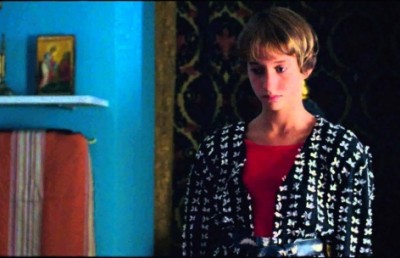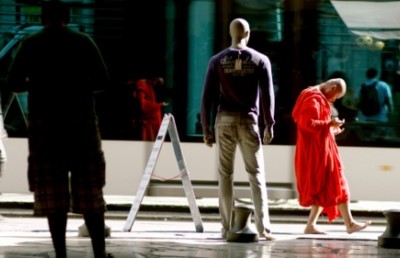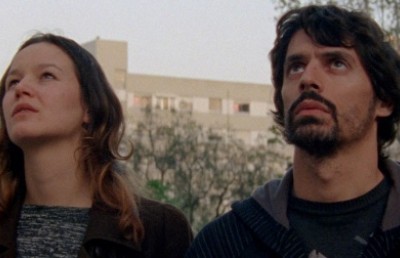The Vancouver International Film Festival, 2014
Veterans Shine: Frederick Wiseman, Im Kwon-taek, Jean-Luc Godard

The Vancouver International Film Festival is my binge period for contemporary cinema. With double-digit prices, the decline in mid-level genre work from Hollywood, and the presence of those blasted glowing phone screens, commercial theatregoing grows less and less attractive as time passes. Most of my movie-going is at non-profit art houses, and that pushes me away from a sense of the present in cinema. VIFF is the antidote to all this: it offers hundreds of contemporary films, from commercial fare to the outer reaches of formal radicalism, and I love attending and writing about it. This year, as in the past, my reviews have to come with a disclosure: I work for the festival on a minor level—this year as a previewer and a copywriter for the program guide. None of the films I viewed in these capacities are under review here.
***
The Festival got off to a good start for me—two superb films in a row. The first movie I saw was Frederick Wiseman’s National Gallery. It’s a long, hard look at the famous public gallery in London: its repository of masterworks, the esoteric techniques of restoration and maintenance applied to them, and the logistical work that goes into keeping the place afloat. About thirty minutes in I was saying to myself, “You won’t see a better film at this year’s festival,” but by the home stretch of this three-hour doc I’d changed my mind a bit. The best thing about the movie, and the thing that gets compromised not so much by length as by repetition, is its self-reflexivity.
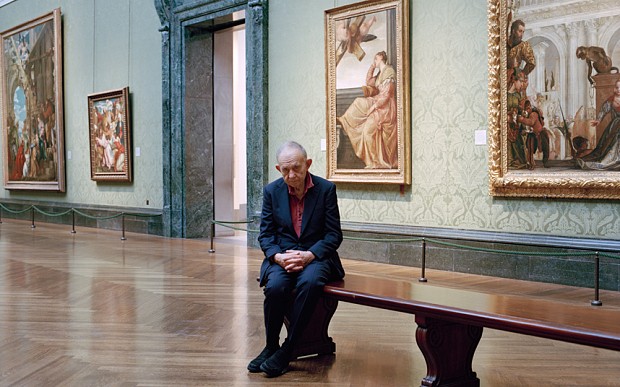
National Gallery
After a montage of paintings with wider views of the rooms they’re mounted in, Wiseman gives us footage from one of those roving small-group lectures that museums do. The lecturer is discussing an old religious work, and asking her audience to imagine themselves inside the type of church it both depicts and was originally displayed in. She wants them to view the artwork as worshippers must have, in flickering candlelight and a situation of pre-modern reverence. Her words are provocative as text, but as material in Wiseman’s design they take on a more self-conscious meaning: they’re part of a layered design, as we look at a movie in which an audience looks at a painting and tries to put themselves inside of it. The chain of spectatorship runs inward, through layers of remove, and this combination of material depiction and Pirandellian gesture forms the core of the film. There are many revelations on a journalistic level: the physical techniques of restoration, the boardroom conflicts over marketing, various grunt work and logistical manoeuvring behind the scenes. But we absorb these things, and the artworks they serve, as self-conscious spectators. As we observe the blind getting a braille-aided lecture on a Camille Pissarro painting, a dance duet staged like a self-conscious tableau of performativity, an expert revealing the abandoned painting hidden behind the oils of a famous masterwork, this and so much more, we’re getting an education on art both literally, from the footage, and figuratively, from an artist whose paintbrush is selection and counterpoint.
It’s wonderful stuff, but for me there’s too much of it: the subtlety of Wiseman’s gestures wears down after awhile, and his documentation of the gallery starts to run back over its own tracks—I could have done with about thirty or forty minutes shaved off. Like his last, At Berkeley (2013), this film is about discourse in the material world, and expansiveness is key to the effect Wiseman creates: a sense of words, ideas and creations as they’re tested by exposure to the wider environment. He needs time to evoke that world, and here as in the past he does so beautifully. But the movie seems focused around a controlling idea, and so it weakens from repetition. Still, as a work of art about the work of art, National Gallery is stimulating, lucid and, for the most part, great fun. The beauty is in what Wiseman documents and in what he creates.
***
Next up for me was Force Majeure (d. Ruben Östlund), a film that could thrill a much wider audience than it’ll get from its festival and art house screenings. Every year at VIFF I see art films of imposing austerity and thematic privacy, and I have moments of lamentation when I think of their diminished chances at any cultural impact beyond the walls—and there are walls, constructed from within as well as imposed from without—of our miniaturized contemporary cinephilia. That sadness turns into anger, though, when I see a movie like this one, which could reach out and touch millions. It has a relatable story, one that cuts to the bone of our deepest human insecurities; it’s also funny, frighteningly plausible, beautiful to look at, and superbly acted. Above all, it’s a white-knuckle thriller: the suspense is near-constant, and it’s embedded in the surrounding environment, the composition and cutting, and the hair-trigger character dynamics.
Johannes Kuhnke plays Tomas, husband to Ebba (Lisa Loven Kongsli) and father of two young children. They’re on a ski holiday in the French Alps—a gorgeous, vertiginous environment made vaguely menacing by the controlled avalanches periodically set off by dynamite. One afternoon the family is seated on a ski lodge balcony, having lunch. An avalanche is set off in the distance, and a huge cloud of powder runs down the hill towards the diners. As it gets closer and closer, Tomas calls out assurances: They know what they’re doing, we’re perfectly safe. But the cloud keeps coming, and there are screams of panic and ducking for cover as the diners are engulfed in powder. Ebba’s immediate response is to grab and cover her children. Tomas’s response is to grab his cellphone and gloves and run. All this is shown in one trick shot, from the distant explosion to the snow-covered aftermath, as the people emerge from their panic and realize they were never in real danger. But Tomas has crossed a line, and the rest of the film deals with the fallout from his cowardice.
In the aftermath of the scare, we get a sense of both predictability and ambiguity. On one hand, there’s a sense of emotional entrapment, the horrible irreversibility of Tomas’s actions and the narrowing of horizons for him: he’s psychologically doomed. But then there are the questions: how is his wife going to respond—with confrontation, withdrawal, or something else? What about the kids—do they understand what their father has done? Does he even understand it? Do we? This movie is a great conversation starter, with the fearful, what-would-you-do curiosity and the juicy philosophical questions to chew on.
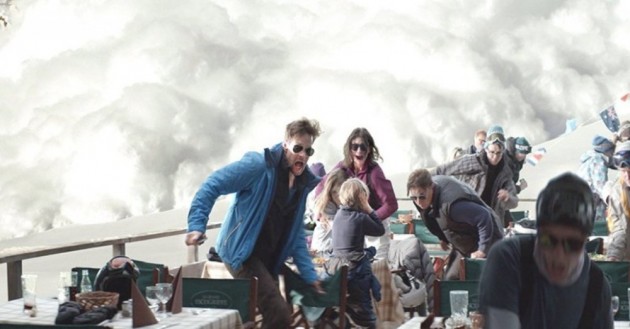
Force Majeure
Force Majeure is one of hundreds of contemporary art films that use exteriority as a structuring principle. From Hou to Kiarostami and dozens of lesser talents, the minimal use of cutting within scenes, the lack of subjectivity, the long takes and the stress on unanswered questions of psychology define contemporary art cinema for better and, increasingly in my view, for worse. But there are still masterpieces being made under this broad rubric, and this is one of them, not least because its retentive distance is married to a Hitchcockian sense of threat. The threat is physical (the towering heights, the recurrent explosions) as well as emotional, and it’s underscored by editing that makes a sharp sliver out of each scene. The psychological mystery is hitched to a pacing, and a withdrawn pictorial style, that inflate uncertainty almost to the point of terror. As Tomas leads his family down a ski run in zero visibility, as a coach bus veers again and again to the edge of a mountain road, as shame and anger near the point of explosion, we’re on the edge of our seats, thinking, caring, feeling.
The most generative movies I saw at this year’s festival were this and Godard’s Goodbye to Language 3D. Both provoke a ton of questions, but the key difference is that Force Majeure limits the range of inquiry, often quite ruthlessly. The tight, constricting shots lock us in as surely as Michael Haneke does in his films, but with a greater attention to off-screen space —that’s where our curiosity, and our freedom, come in. The line of questions here are circumscribed by the story and the direction, and it makes for a balance of clarity and ambiguity. That balance is tipped over in the Godard, where we have so much latitude that we almost get lost.
***
This year’s Festival had two major revelations for me: Pedro Costa’s Horse Money and Goodbye to Language. The Costa may have been less of a shock to me had I been keeping up with the director more diligently, but after two off-putting experiences—a semi-somnolent viewing of Colossal Youth (2006) at VIFF and a wakeful but unpleasant viewing of his music doc Ne Change Rien (2009)—I’d pushed him to the side. This now seems like a dereliction, and not because he’s been anointed as a master by certain very influential cinephiles. I’ll never take my eyes off the guy again after seeing a masterpiece like his latest, and obviously some re-viewing is in order.
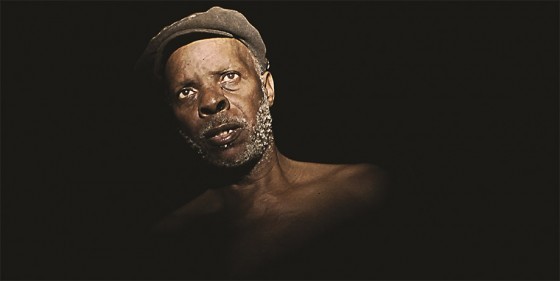
Horse Money
Horse Money takes place in what is probably a hospital but may also be a prison, and perhaps other things as well. It also may or may not be in operation, fully or partially; may or may not be a concrete physical entity; may or may not be the reflection of nightmares made immanent; and may be any of the above at various points in the film, according to need. The simplest, most inclusive way to put it would be that it’s the world of the characters, created in collaboration with Costa, with “world” having the broadest, most flexible connotations.
Costa is certainly part of the global austerity trend, but he’s more expressionistic than any of his peers that I’ve seen. There are angled camera setups, distorting lensing and use of darkness here that remind me of cinematographer John Alton at his most indulgent. What’s different here is the lack of formal symmetry that’s so important to genre films, from those of Alton collaborators Anthony Mann and Joseph E. Lewis to the more unconventional reaches of Val Lewton or Sternberg. The expressiveness in this film is whimsical and undisciplined, more a matter of caprice than formal pattern. The rough-hewn, contingent look of the movie, its wonderfully aimless narrative, and its fast and loose play with logic put it outside any boundaries of genre convention, even as Costa pays auteurist homage. Costa feels no need to integrate his sharp angles and blocks of blackness into a closed form; the techniques may come from old Hollywood and have some value as allusion, but his use of them here is individualistic, and almost hysterically over-pronounced: the movie feels like an act of desperation, an echoing scream heard through the darkness.
The “star” of the film is Ventura, a real-life former occupant of the Fontainhas housing projects who has moved from the periphery to the centre of Costa’s work. Ventura is now reaching the end of his life; he has more to look back on than to look forward to. Sick with something, or with many things, he walks slowly through hallways and sits passively in rooms, speaking to himself and to others including friends, old acquaintances and, in one scene of mad inspiration, a painted soldier in an elevator. What does it all mean? That’s up to us as much as it is to Costa or Ventura. The thematic obliqueness that defines Hou, Kiarostami, Apichatpong and all the other players in “Contemporary Contemplative Cinema” goes hand in hand with their long takes, slow pace and focus on surfaces over interiority. Costa is a part of this tradition, but he gives us a leg up, reflecting Ventura’s misery in visual terms and giving his subject lots of time to express himself in words.
The film is still richly mysterious, mostly for its confusion of time and space. The elevator ride with the soldier takes longer than would be possible in the real world, Ventura’s acquaintances appear and disappear like points on a train of thought, and we have little idea how much time passes between scenes. With his distended takes and his indifference to sequential logic, Costa is favouring real time over story time. This short-range temporal realism is common these days, but Costa is a rarity for combining it with such garish visuals. What the movie “means” to me is that Ventura is a lonely soul with a lot of bad memories, a good man near the end of his days in a country that recent history has not been kind to, and that Costa is decrying all of this and trying to put us in a position to experience his country’s pain indirectly.
But I’ll also speak in affective terms, since Horse Money drew out emotions from my past and brought them right to the surface, making the movie an experience of remembering as well as discovery. I had the feeling, familiar from my own long hospital stay, of lying awake at 2 AM in bed, with the squeak of gurney wheels and cries of pain passing through the privacy curtain, feeling the sweat from a short sleep of nightmares gone cold on the sheets, knowing I wouldn’t fall back asleep and staring down the barrel of another night of loneliness and misery. Imagine that kind of feeling and add to it layers of national, political and historical tragedy, separate rings of gloom wrapped around one old man, giving him only enough room to walk aimlessly. The movie is a perfect evocation of depression: the future collapses because it holds no hope, and promises only a continuation of the present; the past is a tormenting memory; and the present is a liminal state with no destination in sight —a void, more or less. Ventura eventually frees himself from the building, but even loose on the streets it’s unclear where he’ll go.
I take it that readers of this piece don’t need pleading on behalf of movies that are “dark,” “depressing” or “sad,” because they know that almost anything can be beautiful if it’s formed and contained in art. So just a few more words about the containment of woe in this movie: it’s elaborated in Ventura’s flat affect, the pain in his voice as he speaks, and the dark expanses of the setting, which seems both endless and brutally confining. Costa and his collaborators have turned a mind state into a world; for all the raggedness and randomness on view, the movie builds a synchronicity between location and mood, action and idea, that is near-total. With sadness as an empty hallway, terror as a dark stairwell, and the inside of an elevator as history, the physical world exists as meaning in a way one usually associates with painting. Mulishly, courageously, Costa turns a conception of stasis into motion, and does not once vary the pace or tone. To turn setting into feeling like this is to transcend materiality. As a work of miserablism, the movie’s only rivals I can think of would have to be found in the work of Fassbinder, but Horse Money is more staggering for Costa’s metaphysical bent. His combination of physicality and abstraction is as strange, as rare, as beautiful as anything I’ve seen in a lifetime at the movies.
***
David Bordwell has called Godard “the world’s youngest 83 year old filmmaker,” and that seems half right to me. Watching recent works like Notre Musique (2004) and Film Socialisme (2010), one thinks of Rossellini’s remark about Chaplin’s A King in New York (1957): “It’s the film of a free man.” Godard is in one sense a very free man —his recent movies are bursts of anarchic, heedless experimentation and indicate a lack of any consideration besides personal expression. But it’s hard —for me, at least— to separate the stylistic fireworks and privacy of meaning from a status of less consequence— on a commercial level, secondarily, but more importantly on a cultural one. Recent Godard combines the bitterness and funereal demeanor of a very old man with the aesthetic brio of a twenty-year-old filmmaker. At least, that’s been my reflexive characterization of it in the past, but maybe his reckless experimentation is just another product, with the crabbiness and gloom, of diminishment: maybe Godard is just a man with little left to lose. His audiences have shrunk drastically, and this has happened in tandem with the contraction of cinephilia from a strong cultural force to the private domain of a dedicated few and, in turn, the increase of formal radicalism in international art cinema. And then there’s ideology: late Godard is redolent with anger at the dimming of revolutionary prospects and the triumph of the forces he despises. One can track the changes in temperament by comparing the excited whispering of 2 or 3 Things I Know About Her (1967) to the croaking, mournful drone of his voice in recent films; it’s a change that reminds me of early vs. late Leonard Cohen. “Everybody knows that the war is over/Everybody knows the good guys lost.”
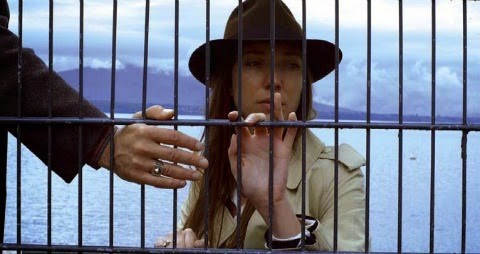
Goodbye Language 3D
Writing snidely about the radicalism of Film Socialisme, Todd McCarthy mocked the reaction of some of his fellow critics: “ ‘I really need to see it again.’” I saw Goodbye to Language 3D twice at VIFF ’14, and I would have seen it three times if I could have gotten into its first screening. All three showings sold out, although I’m sure there was quite a bit of befuddlement —at the end of my first screening, a woman called out “We’ve been had!” Speak for yourself, lady. I had a blast, though on my second time I emerged a little more skeptical.
There are three elements to the film’s narrative —not storylines, not discrete sections (though there are two misleading chapter markers), but elements. That’s the best word I can think of, and it reflects not so much sequence as difference of focus. The first element is a jumble of footage mixing outdoor conversation with found footage and Godardian musings. It’s easier to recall gist than specifics in movies, and never more so than with recent Godard. Overall, the first element adds up to a lament at the state having permeated our lives with the same thoroughness that was aimed for by actual totalitarians (“Hitler invented nothing.”). As part of this lament there are musings on the difficulty of communication and the teasing, obfuscated elements of a kidnapping plot.
The second and third elements come after the first, and are mixed together in time: they consist of looks at the domestic situation of a hetero couple and, best of all, copious footage of Roxy Miéville, who gives the performance of the year in my books. Roxy is Godard and partner Anne-Marie Miéville’s dog, and in his poking snout, wide-open eyes and free, impulsive movements one gets a sense of unity that that Godard envies. Roxy is without language, he is pure, he is undivided.
The nexus point of these three elements is the idea of wholeness, of the reconciliation of contradictions in the savage, innocent form of a canine. That’s how I see it, anyway. It goes without saying that there are a hundred varying interpretations that could compete with mine; thematically, recent Godard is close to Rorschach level. The difference is that each of us interprets not a static shape but what is probably the most complex interplay between text, image and sound in all of cinema. The eclecticism of his recent masterworks is beautiful in part because of the discipline it enforces: it makes us into rapid-response critics, making sense of counterpoint as elements fly at us, a calisthenics of exegesis that ends only when the film does. Adding 3D to this mixture is almost too much. I would have been happier to have its 70 minutes stretched out; there’s always the necessity of contemplation in Godard, but here the opportunities for it are a bit too squeezed. The gnomic register, proliferation of ideas and borderline non-narrative form are nothing new in his work, but in the past they’ve been offset by stronger semblances of narrative, or at least a slower pace.
James Cameron yanked 3D up to date by building a streamlined accumulation of depth in Avatar (2009). Godard seems as interested in creating disjunction as he is in following the new innovations; the crude hierarchy of mise en scène that marked old-school 3D is in strong evidence here. He uses the technology for exaggeration more than visual realism, and its application to non-spectacular footage heightens the sense of surprise. Godard seems to be parodying representation —not so much out of malice or cynicism as to produce a sense of wonder and alienation. I use those terms to denote the key aims of Godard’s oeuvre, and that of countless artists in the modern age: to encourage interrogation of the work, and to use defamiliarization to evoke a thrill, with our recognition of the real made fresh and strange again. The depth in Goodbye To Language puts us in conflict with everyday vision as has never been done before on film, and what comes out of that is, among other things, a sense of terminus. Where do we go from here? The stalemate of mutual alienation between man and woman, the triumph of “the state,” and the lack of political hope point towards despair, but listen closely: the cries of a baby near the end may spell hope, a future existence where the defeat of leftism, the failures of representation and the impasse of language will be overturned. That’s my guess, anyway —after two screenings the nebulous and the tentative are all I can muster. I need to see it again —and, more than that, I want to.
***
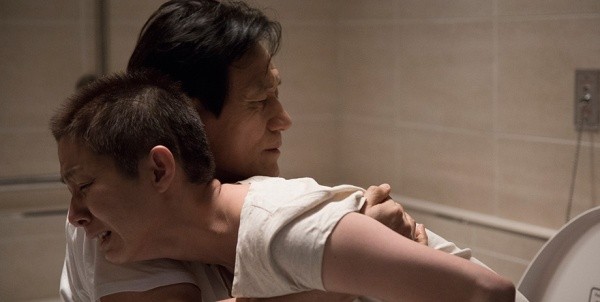
Revivre
Two more Festival standouts, both from South Korea. Revivre is Im Kwon-taek’s 102nd film, and he directs it with an economy that speaks to decades of refinement. Oh Jeongseok (Ahn Songgi) is a professional man nearing retirement. He spends much of the movie caring for his wife (Kim Hojung), who is hospitalized, wracked with pain and approaching death. “You’re waiting for me to die, aren’t you?” she says to him, and he has no proper answer. He’s a great movie character, full of the kind of mystery that cinema, with its bias toward the exterior, is made to portray. As the story moves along, introducing his attraction to a young woman (Kim Gyuri), we’re led to wonder whether his reserve is a matter of honour or one of fear. The answer is, probably, both: he loyally cares for his wife, but the ethic of stoic uprightness that drives this generosity have made him a cold, distant partner through years of marriage. The same sense of rectitude carries on needlessly after his wife’s death, and there its connection with fear is clear, as he walks away from an affair that would be a godsend for any man his age.
Revivre is, pace Truffaut on Welles’ Touch of Evil (1958), a film about the weakness of the strong. It’s a whisper of a film in which the dialogue seems almost overwhelmed by the silences that surround it, and its emotional power comes through without ever breaking the spell of repose. It’s a movie that would do Ozu proud, but still a genuine original.
Kang Sang-woo scored at VIFF 2010 with A Silk Letter, one of the strongest feature debuts I’ve seen. He was back in ’14 with a short, Clean Me, that has the same mixture of anger and sexual thirst. A Silk Letter took place largely in the apartment of a young gay man and his lover, and it dealt with its’ protagonist’s refusal to perform military service. Kang himself refused the draft, and he served time for it. His latest is the story of a young gay man just released from jail, stuck in a rehabilitative work program in which he labours as a janitor. Over the course of the film we get the story of his coupling with another young man; their coming together is staged as both an act of defiance and a desperate seeking of refuge.
Aside from this marriage of politics and passion, what’s striking about the film is its style, and on this score it shares its distinction with many contemporary films from S. Korea. One way to outline this special quality is in negative terms: the films eschew both the accelerated cutting of contemporary Hollywood and the long-take fetishism of nearly all festival-circuit art cinema. In these films, both genre and non-commercial, cutting is part of a formula of tension and visual revelation. Directors will break a scene down in the old-fashioned manner, with cutting and composition sharing equal importance and each playing off the other —not just between scenes but within them. This sounds basic to the art of narrative filmmaking, but it’s surprisingly rare these days, with montage overwhelming any strong sense of tension in Hollywood and reduced to a minimum in its counterculture opposite.
You can see this play with concealment and discovery throughout Clean Me: in sequences that halve men’s bodies, delaying identification before rewarding us with a face; in a shot that moves laterally to reveal a character and then pushes in from behind him in a halting gesture of intimacy; and in the deferral of any exterior shots until five minutes into this twenty-minute movie. As in A Silk Letter, intimacy and tension are conjoined, and the sense of physical love gains power within a surrounding climate of oppression. Cinematic form fits Kang like a glove, and he knows how to use it to register his passion, which, beautiful as it is, is inseparable from anger.



